Music Man Amps: An Undervalued Pedal Platform in the Vintage Market

Every musician's journey is marked by evolution - an evolution of skills, tastes, and gear. My own journey has been no different. Having started with a simple setup, I gradually moved towards an ampless rig, embracing the flexibility and convenience it offered. However, life has a way of throwing curveballs, and mine came in the form of joining a metal band that relied on traditional 100W amps. Amidst the sea of options, one amp, located in a local paintball shop, stood out to me: the Music Man 210-HD One Thirty.
In this article, we'll be taking a look at not only my personal experiences with a Music Man amplifier, but also the history, some famous users, and even considerations to make when looking at purchasing one for yourself.
History of Music Man Amps
Music Man has a rich history that dates back to 1971 when it was formed by Leo Fender, Forrest White, and Tom Walker. Initially named "Tri-Sonics, Inc.", the company saw Leo and Tom working on the amplifiers while Forrest focused on designing guitars and basses that wouldn't be confused with Fender instruments.
By 1973, the company name was changed to "Musitek, Inc.", short for "Music Technology". However, it wasn't until January 1974 that the company adopted its final name, "Music Man". During this period, Leo Fender was cautious about taking an active role in the company due to his 10-year "non-compete" clause with CBS, which had bought Fender Musical Instrument Company in 1965.
In 1975, Leo Fender announced that he had been elected president of Music Man, Inc. The production of amplifiers had already started in 1974, with the earliest versions of the "Sixty Five" series. The company continued to produce these amps and their 130-watt brethren until 1979 with few changes, except for the transition to a solid-state phase splitter design.
However, due to internal mismanagement and ownership disputes, the company faced financial difficulties. After considering several offers, Music Man was sold to Ernie Ball on March 7, 1984, marking the end of an amazing decade in musical instrument amplifiers.
Exploring the Models
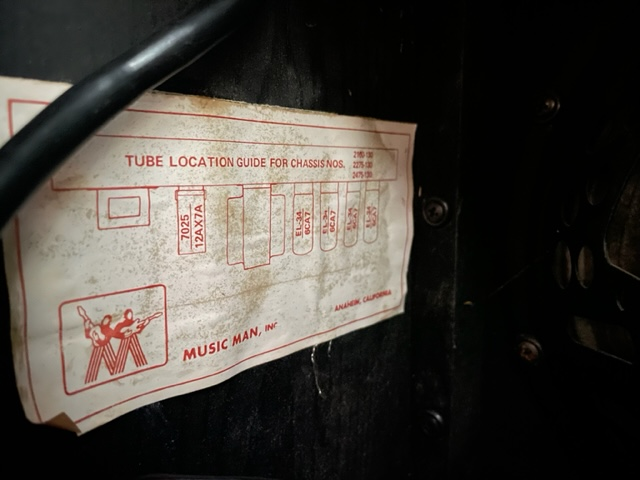
Music Man produced a wide variety of models of just a couple of decades. The earliest versions are the "Sixty Five" series, which started production in 1974, were equipped with a 12AX7 phase splitter and a pair of Sylvania 6CA7 output tubes. These amps, along with their 130-watt counterparts, were produced until 1979 with the only change being a swap to a solid state phase splitter during later production models. These will be the most commonly available units and include the:
- 65 (head)
- 65 Reverb (head)
- 112-65 (1x12" Combo)
- 115-65 (1x15" Combo)
- 210-65 (2x10" Combo)
- 410-65 (4x10" Combo)
- HD-130 (head)
- HD-130 Reverb (head)
- 210HD-130 (2x10" combo, and the one that I own and referenced for this review)
- 410HD-130 (4x10" combo)
- 212HD-130 (2x12" combo)
In late 1979 and into 1980, new amps were introduced. These mainly included upgrades to the power output and the addition of the RD (Reverb/Distortion) and RP (Reverb/Phasor) models. The company also underwent a corporate identity change, which primarily involved reversing the color scheme of the logo plates.
Throughout the early '80s, Music Man continued to introduce new models and cosmetic changes. This period saw the introduction of the smallest amps such as the RD/RP50 and the uprated RD/RP100 series. All of which are harder to find than the earlier 70s amps. It was also during this time that the even rarer white tolex and white "pinwhal" (a sort of vinyl corduroy) coverings were introduced.
The Unique Sound of Music Man Amplifiers
While a Music Man amp may bear a visual resemblance to Fender amps, their sonic characteristics are distinct and have a charm of their own. Both amps are known for their clean tones and headroom, but when it comes to the EQ and overdriven tones have some distinct differences.
Fender amps, especially the classic 'Blackface' and 'Silverface' models, are renowned for their bright, sparkling clean tones with a pronounced mid-scoop. They have a chimey top-end and a tight low-end, which makes them a favorite for many blues, country, and rock players.
Music Man Amps, on the other hand, offer a more balanced tonal spectrum. They still incorporate a bump in the high mid range, but lack the mid-scoop that characterizes the Fender sound. This gives them a thick, full-bodied tone with a smooth, but pronounced high end and a robust, punchy low end.
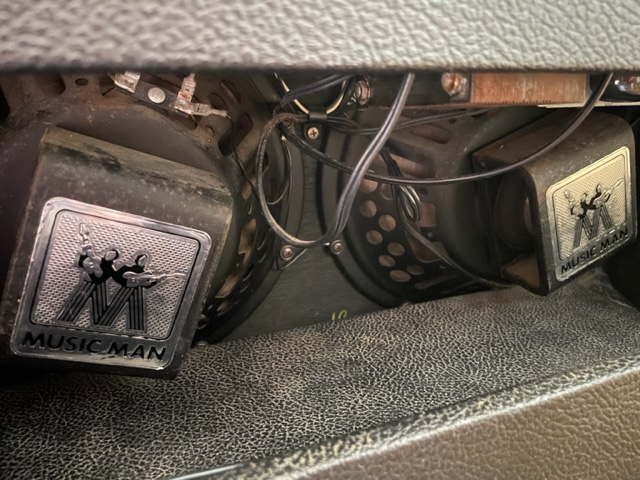
When pushed into overdrive, Fender amps tend to break up into a gritty, crunchy tone that's a staple of blues and rock music. Music Man Amps, however, have a smoother and more harmonic overdrive tone. This is in part due to their hybrid design, which combines a solid-state preamp with a tube power section. This design allows the amps to maintain their clean headroom at higher volumes, and when they do break up, the overdrive is warm and musical.
Due to their unique sound, reliability, and versatility, Music Man amps have found their way into a wide variety of genres including blues, jazz, rock and even finger picking country.
Buying Second Hand: What to Avoid
When buying any used amplifier, including a Music Man, it's essential to do your due diligence to ensure you're getting a quality piece of gear. If you have the opportunity to test the amp in person, be sure to thoroughly check all knobs and switches for functionality. Look inside the amp at the tubes to check for mismatched tubes or signs they've been replaced or need to be replaced. The general condition of the amp can also give you a feel for how well it has been treated or if it was abused.
If you can't test an amp in person (say you're buying one online) ask for the following:
- Service history (if any)
- Pictures of the tubes
- Pictures of the transformer (more on that below)
- Video showcasing the amp functioning at both lower and higher volumes
- Video showing that each knob functions as expected
One unique consideration when buying a second-hand Music Man is the potential for rusty transformers. Rust on transformer laminations can cause electrical conductivity along the surface of the affected laminations, promoting "eddy-currents" which lower the magnetic efficiency of the transformer. This can lead to increased core temperatures and current losses. In the worst-case scenario, such a transformer will not work at all and may cause the amp to blow primary AC fuses.
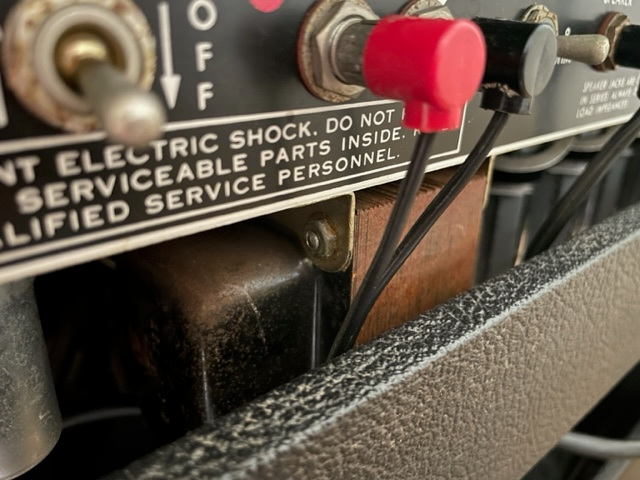
If you encounter light rust on an otherwise working transformer, the best thing to do is to either leave it alone or apply a coat of paint or sealer to prevent further rust. In my case, my 210-HD has a rusty transformer, but it hasn't caused any issues.
Maintenance and Servicing
If you do find yourself the owner of a Music Man, or other vintage amplifier, you'll want to be aware of the potential need for servicing and maintenance.
Capacitors, in particular, can go bad over time, and their failure can cause significant damage to the amp. It's generally recommended to replace capacitors on any amp that's older than 20-30 years if there's no record of them being serviced, even if the amp is working perfectly fine. The cost of this service can vary, but I paid just under $200 to have it done on my amp.
You may also need to replace the Tubes, though the original tubes in Music Man amplifiers are known for their longevity. Case in point, my amp still features it's original tubes!
Understanding the Amp's Knobs and Settings
Music Man Amps are known for their unique features and settings that set them apart from other amplifiers. These features contribute to the versatility and distinct sound of these amps.
Bright and Deep Switches
One of the unique features of Music Man Amps is the bright switch. This switch appears to boost all frequencies above 2k hz, giving the tone a pronounced high mid bump, but also resulting in some ice pick like treble frequencies coming through. The use of the switch can be polarizing, but definitely expands the tonal palette.
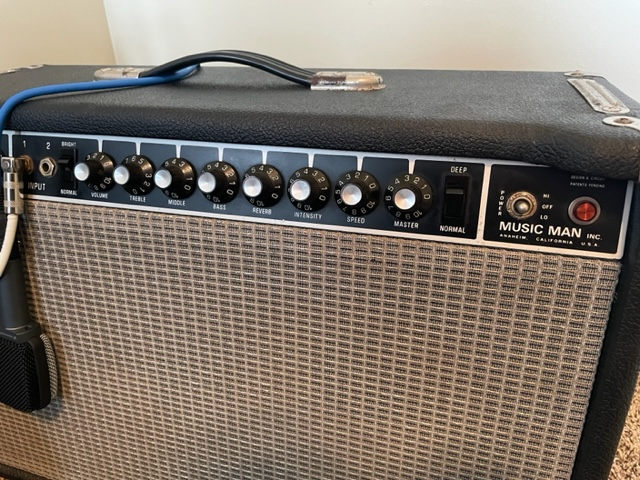
Another unique feature is the deep switch. This switch boosts frequencies from about 100hz to 300hz, and unlike the bright switch, isn't as stark of a difference (at least with guitar in standard tuning). This can be especially useful for styles that require a fuller, richer sound. Additionally, while it's placement may suggest it only works on the 2nd channel, the deep switch affects both channels.
2 Channels
The differences between channel 1 and channel 2 also contribute to the versatility of these amps. Channel 1 is known for its fuller and thicker sound, while channel 2, which features the reverb and tremolo, and offers a lighter and brighter tonal palette.
In our testing, we found that Channel 2 features a more pronounced bump at 2-3k hz and rolls off the bass frequencies more, whereas channel 1 has a more balanced EQ overall, with more bass and low mids coming through the mix.
The ability to bridge the two channels (shown in the image below) further expands the tonal possibilities.
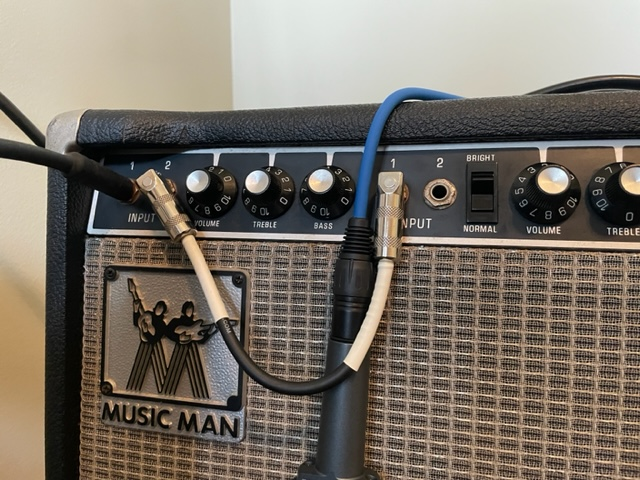
If your channel 1 doesn't have a mids knob (like mine), the value is equivalent to a 4, so setting the treble and bass to 4 would give you a "flat" EQ.
Tremolo or Univibe?
The tremolo on Music Man Amps is also unique. The Intensity knob from 0-5 works as a standard tremolo's 0-100%. When set above 5, as second modulation pulse is added, creating a sound similar to a rotary speaker or univibe.
hi/lo Switch
Finally, the hi/lo switch is another unique feature of Music Man Amps. Unlike other amps that remove tubes to reduce power, this switch reduces the voltage to the plate. This means the amp breaks up sooner, giving you more distortion at lower volumes, and it also helps the tubes last longer.
Famous Users and Their Settings
Music Man Amps have been used by many famous musicians over the years, but perhaps the two most famous are Eric Clapton and Joan Jett.

Eric Clapton is known to have modded his music man to suit his needs. Some circuits are shared online showcases the mods, but I can't attest to the accuracy of them. Generally the consensus is that the bright switch and gain were modified.
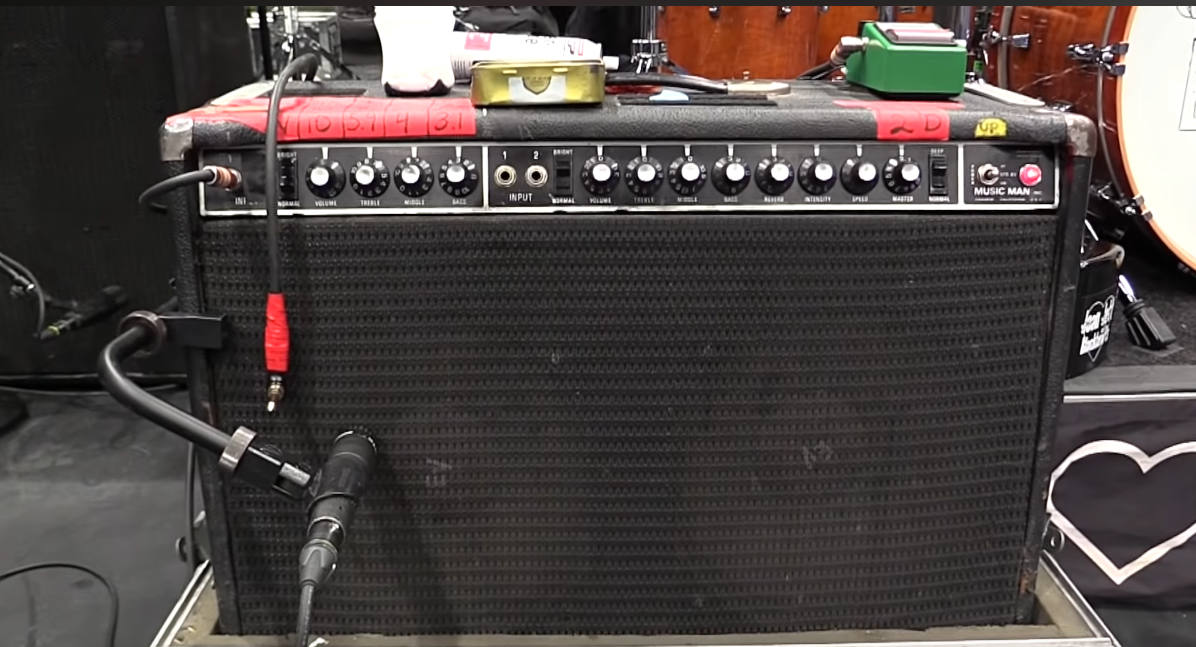
Joan Jett's guitar tech shares that she uses a 212HD-130 with a HD-130 head as a backup when playing live and recording. She swapped the tubes to JJs and runs through the first channel, with the bright switch on, treble at 8, mids at 7.5, bass at 3.5, and volume at 10, using the master to control volume and channel volume for the gain. It also appears that she swapped the stock speakers for Electro Voice speakers, but the exact model is unknown. This setup gives her a powerful, punchy tone with plenty of grit and attitude.
My Personal Experience with a Music Man 210-HD One Thirty
I think it's important to start this off by discussing why I decided to buy a vintage amp. I have a strong desire to live my life in a way that minimizes waste. Many newer amps, while offering a range of modern features, are not only expensive but are also designed in a way that makes them hard to repair. In some cases, they even come with built-in defects or parts operating beyond their designed tolerances (planned obsolescence?).
I didn't want an amp that could, not only fail on me at a gig, but also contribute to more waste at land fills. Vintage amps, if well-built and well-maintained, can offer reliability and longevity. They've stood the test of time, and if they've held up over so many decades, they're likely to continue to do so.
However, the price of vintage amps can quickly escalate, making them inaccessible to many musicians. This is where the Music Man 210-HD One Thirty stood out. It's a vintage amp that's not only reliable but also relatively affordable, often cheaper than even new amps. While its sound may not be perfect for metal when used standalone, it serves as a phenomenal pedal platform and an excellent choice for rock if you desire an amp driven tone.
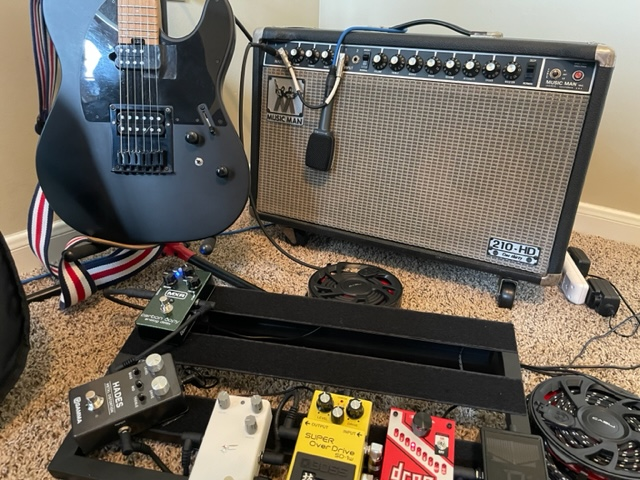
I run distortion pedals into the front of the amp, and it handles them extremely well, delivering a rich and full sound. After some time of use, I've found enjoyed the amp best when run through channel 1, with the channel volume set between 1 and 2 (perfectly clean) and EQ settings "flat" with treble and bass set at 4.
This leads to one of my few gripes about the amp which is that the bridged channels and 2nd channel don't sound nearly as good, causing me to miss out on the use of the amp's excellent built in reverb and tremolo.
The only other challenge is the weight - which is often mentioned online. The amps are built like a tank, which is great for reliability, but not so much for your back. I'm young and fit so it's not that big a deal to me, but in 20 years? yeah I could see that being a problem.
Conclusion
In the world of music, change is the only constant. As musicians, we continuously evolve, adapting our skills and our gear to meet our changing needs and preferences. The Music Man 210-HD One Thirty has been a significant part of my own evolution. Its unique features, sound, and versatility have not only enriched my tone but also reshaped my approach to gear. It's a testament to the enduring appeal of well-built, reliable vintage amps.
If you have the chance to check one out that's local to you, definitely do so, you may just find yourself coming home with a rad, overlooked vintage amp.